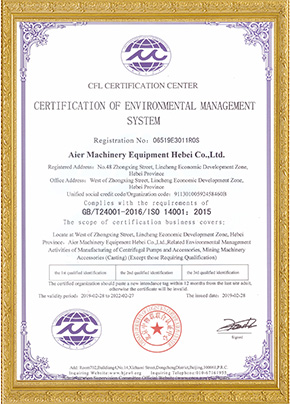Sep . 27, 2024 18:52 Back to list
fgd pump manufacturers
The Role of FGD Pumps in Industrial Applications
Flue Gas Desulfurization (FGD) is an essential process in many industrial applications, particularly in power generation and manufacturing, aimed at reducing sulfur dioxide (SO2) emissions. One of the critical components in the FGD process is the pump, specifically designed for handling the corrosive slurry created during the desulfurization process. In this article, we will explore the significance of FGD pumps, their specific requirements, and how various manufacturers are adapting to meet the evolving needs of the industry.
Understanding FGD Systems
FGD systems are installed at power plants and industrial facilities to remove harmful SO2 from flue gases before they are released into the atmosphere. The most common method for SO2 removal involves a wet scrubbing process where a limestone slurry is used to absorb SO2 from the flue gas, converting it into calcium sulfite, which can then be further processed for disposal or utilization. This process generates a hazardous and corrosive slurry that must be efficiently transported through the system, making the choice of pump critical.
The Importance of FGD Pumps
FGD pumps are specifically engineered to handle the unique challenges associated with transporting this corrosive slurry. Unlike standard pumps, FGD pumps must be capable of dealing with highly abrasive materials, variations in flow rates, and acidic conditions without compromising performance or safety. They are often classified into several types, including centrifugal pumps, diaphragm pumps, and progressing cavity pumps, each serving specific roles within the FGD system.
1. Centrifugal Pumps These are commonly used due to their efficiency in moving large volumes of fluid. However, they need to be designed with specialized materials such as high-chrome alloys or rubber linings to withstand wear from abrasive particles present in the slurry.
2. Diaphragm Pumps These pumps are ideal for handling viscous slurries and are often employed in situations where precise flow control is necessary. Their ability to run dry and handle variations in pressure makes them valuable in FGD applications.
3. Progressing Cavity Pumps These pumps are known for their ability to handle shear-sensitive and corrosive fluids while maintaining a constant flow rate. They are particularly effective in moving viscous slurries, making them suitable for more complex FGD setups.
Selection Criteria for FGD Pumps
Choosing the right pump for an FGD application involves considering several attributes
fgd pump manufacturers

- Material Composition The materials used in the pump construction must be resistant to corrosion and abrasion. Common materials include stainless steel, high-chrome iron, and specialized polymers.
- Flow Capacity and Head Pumps must be selected based on the required flow rate and the head needed to move the slurry through the FGD system, taking into account factors such as the distance and elevation to the disposal point.
- Efficiency Energy-efficient pumps can significantly reduce operational costs, particularly in large-scale FGD systems. Manufacturers are increasingly focused on developing pumps that offer high efficiency without sacrificing reliability.
- Ease of Maintenance Given the corrosive nature of the fluids involved, pumps should be designed for ease of maintenance and accessibility, minimizing downtime for repairs.
Leading FGD Pump Manufacturers
Several manufacturers are recognized for their expertise in producing FGD pumps. Companies like Flowserve, Grundfos, and KSB have significant market presence due to their innovative designs and high-quality materials engineered to perform under the demanding conditions typical of FGD processes.
- Flowserve Known for their advanced fluid motion and control solutions, Flowserve offers a wide range of FGD pumps that are optimized for both efficiency and durability.
- Grundfos This manufacturer focuses on sustainable pump solutions and has developed products specifically designed to minimize wear and tear in FGD applications.
- KSB With a long history in manufacturing pumps and valves, KSB provides tailored solutions for the FGD industry, ensuring compliance with environmental regulations while enhancing operational efficiency.
Conclusion
In conclusion, FGD pumps are a vital component in the battle against industrial pollution. Their ability to manage corrosive and abrasive slurries efficiently is critical for the effectiveness of FGD systems. As environmental regulations become more stringent, the demand for advanced, reliable pump technologies will continue to grow. Manufacturers are responding to this need by innovating solutions that not only meet industrial requirements but also support a sustainable future. Investing in quality FGD pumps is not just a strategic operational decision but a step towards reducing the environmental footprint of industrial processes.
-
Top Submersible Pump Companies High Quality Manufacturers & Suppliers in China
NewsJul.08,2025
-
High Quality Seal for 5 Inch Dredge Pump Reliable China Manufacturer & Supplier
NewsJul.08,2025
-
High-Efficiency Slurry Sand Pump from Leading China Manufacturer – Durable & Reliable Solutions
NewsJul.07,2025
-
High-Quality Slurry Pump Made in China Durable Steel Mill Slurry Pump & Parts
NewsJul.07,2025
-
High Quality Excavator Dredge Pump Manufacturer & Suppliers from China – Reliable, Durable, Efficient Solutions
NewsJul.07,2025
-
Wholesale Slurry Pump Closed Impeller Supplier High Efficiency China Slurry Pump Closed Impeller
NewsJul.06,2025
